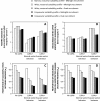Potential causes and consequences of behavioural resilience and resistance in malaria vector populations: a mathematical modelling analysis
- PMID: 24629066
- PMCID: PMC3995604
- DOI: 10.1186/1475-2875-13-97
Potential causes and consequences of behavioural resilience and resistance in malaria vector populations: a mathematical modelling analysis
Abstract
Background: The ability of mosquitoes to evade fatal exposure to insecticidal nets and sprays represents the primary obstacle to eliminating malaria. However, it remains unclear which behaviours are most important for buffering mosquito and parasite populations against vector control.
Methods: Simulated life histories were used to compare the impact of alternative feeding behaviour strategies upon overall lifetime feeding success, and upon temporal distributions of successful feeds and biting rates experienced by unprotected humans, in the presence and absence of insecticidal nets. Strictly nocturnal preferred feeding times were contrasted with 1) a wider preference window extending to dawn and dusk, and 2) crepuscular preferences wherein foraging is suppressed when humans sleep and can use nets but is maximal immediately before and after. Simulations with diversion and mortality parameters typical of endophagic, endophilic African vectors, such as Anopheles gambiae and Anopheles funestus, were compared with those for endophagic but exophilic species, such as Anopheles arabiensis, that also enter houses but leave earlier before lethal exposure to insecticide-treated surfaces occurs.
Results: Insecticidal nets were predicted to redistribute successful feeding events to dawn and dusk where these were included in the profile of innately preferred feeding times. However, predicted distributions of biting unprotected humans were unaffected because extended host-seeking activity was redistributed to innately preferred feeding times. Recently observed alterations of biting activity distributions therefore reflect processes not captured in this model, such as evolutionary selection of heritably modified feeding time preferences or phenotypically plastic expression of feeding time preference caused by associative learning. Surprisingly, endophagy combined with exophily, among mosquitoes that enter houses but then feed and/or rest briefly before rapidly exiting, consistently attenuated predicted insecticide impact more than any feeding time preference trait.
Conclusions: Regardless of underlying cause, recent redistributions of host-biting activity to dawn and dusk necessitate new outdoor control strategies. However, persistently indoor-feeding vectors, that evade intradomiciliary insecticide exposure, are at least equally important. Fortunately, recent evaluations of occupied houses or odour-baited stations, with baffled entrances that retain An. arabiensis within insecticide-treated structures, illustrate how endophagic but exophilic vectors may be more effectively tackled using existing insecticides.
Figures







References
-
- Durnez L, Coosemans M. In: Anopheles mosquitoes – New insights into malaria vectors. Manguin S, editor. Rijeka: Intech; 2013. Residual transmission of malaria: an old issue for new approaches; pp. 671–704.
Publication types
MeSH terms
LinkOut - more resources
Full Text Sources
Other Literature Sources
Medical

